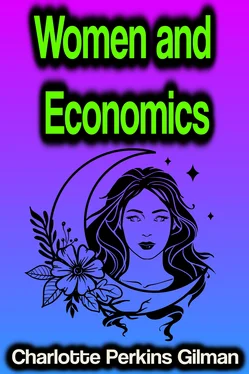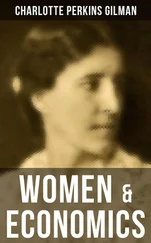To define "excess" in this connection is not difficult. All natural functions that require our conscious co-operation for their fulfilment are urged upon our notice by an imperative desire. We do not have to desire to breathe or to digest or to circulate the blood, because that is done without our volition; but we do have to desire to eat and drink, because the stomach cannot obtain its supplies without in some way spurring the whole organism to secure them. So hunger is given us as an essential factor in our process of nutrition. In the same manner sex-attraction is an essential factor in the fulfilment of our processes of reproduction. In a normal condition the amount of hunger we feel is exactly proportioned to the amount of food we need. It tells us when to eat and when to stop. In some diseased conditions "an unnatural appetite" sets in; and we are impelled to eat far beyond the capacity of the stomach to digest, of the body to assimilate. This is an excessive hunger.
We, as a race, manifest an excessive sex-attraction, followed by its excessive indulgence, and the inevitable evil consequence. It urges us to a degree of indulgence which bears no relation to the original needs of the organism, and which is even so absurdly exaggerated as to react unfavorably on the incidental gratification involved; an excess which tends to pervert and exhaust desire as well as to injure reproduction.
The human animal manifests an excess in sex-attraction which not only injures the race through its morbid action on the natural processes of reproduction, but which injures the happiness of the individual through its morbid reaction on his own desires.
What is the cause of this excessive sex-attraction in the human species? The immediately acting cause of sex-attraction is sex-distinction. The more widely the sexes are differentiated, the more forcibly they are attracted to each other. The more highly developed becomes the distinction of sex in either organism, the more intense is its attraction for the other. In the human species we find sex-distinction carried to an excessive degree. Sex-distinction in humanity is so marked as to retard and confuse race-distinction, to check individual distinction, seriously to injure the race. Accustomed as we are simply to accept the facts of life as we find them, to consider people as permanent types instead of seeing them and the whole race in continual change according to the action of many forces, it seems strange at first to differentiate between familiar manifestations of sex distinction, and to say: "This is normal, and should not be disturbed. This is abnormal, and should be removed." But that is precisely what must be done.
Normal sex-distinction manifests itself in all species in what are called primary and secondary sex-characteristics. The primary are those organs and functions essential to reproduction; the secondary, those modifications of structure and function which subserve the uses of reproduction ultimately, but are not directly essential,–such as the horns of the stag, of use in sex-combat; the plumage of the peacock, of use in sex-competition. All the minor characteristics of beard or mane, comb, wattles, spurs, gorgeous color or superior size, which distinguish the male from the female,–these are distinctions of sex. These distinctions are of use to the species through reproduction only, the processes of race-preservation. They are not of use in self-preservation. The creature is not profited personally by his mane or crest or tail-feathers: they do not help him get his dinner or kill his enemies.
On the contrary, they react unfavorably upon his personal gains, if, through too great development, they interfere with his activity or render him a conspicuous mark for enemies. Such development would constitute excessive sex-distinction, and this is precisely the condition of the human race. Our distinctions of sex are carried to such a degree as to be disadvantageous to our progress as individuals and as a race. The sexes in our species are differentiated not only enough to perform their primal functions; not only enough to manifest all sufficient secondary sexual characteristics and fulfil their use in giving rise to sufficient sex-attraction; but so much as seriously to interfere with the processes of self-preservation on the one hand; and, more conspicuous still, so much as to react unfavorably upon the very processes of race-preservation which they are meant to serve. Our excessive sex-distinction, manifesting the characteristics of sex to an abnormal degree, has given rise to a degree of attraction which demands a degree of indulgence that directly injures motherhood and fatherhood. We are not better as parents, nor better as people, for our existing degree of sex-distinction, but visibly worse. To what conditions are we to look for the developing cause of these phenomena?
Let us first examine the balance of forces by which these two great processes, self-preservation and race-preservation, are conducted in the world. Self-preservation involves the expenditure of energy in those acts, and their ensuing modifications of structure and function, which tend to the maintenance of the individual life. Race-preservation involves the expenditure of energy in those acts, and their ensuing modifications of structure and function, which tend to the maintenance of the racial life, even to the complete sacrifice of the individual. This primal distinction should be clearly held in mind. Self-preservation and race-preservation are in no way identical processes, and are often directly opposed. In the line of self-preservation, natural selection, acting on the individual, developes those characteristics which enable it to succeed in "the struggle for existence," increasing by use those organs and functions by which it directly profits. In the line of race-preservation, sexual selection, acting on the individual, developes those characteristics which enable it to succeed in what Drummond has called "the struggle for the existence of others," increasing by use those organs and functions by which its young are to profit, directly or indirectly. The individual has been not only modified to its environment, under natural selection, but modified to its mate, under sexual selection, each sex developing the qualities desired by the other by the simple process of choice, those best sexed being first chosen, and transmitting their sex-development as well as their racial development.
The order mammalia is the resultant of a primary sex-distinction developed by natural selection; but the gorgeous plumage of the peacock's tail is a secondary sex-distinction developed by sexual selection. If the peacock's tail were to increase in size and splendor till it shone like the sun and covered an acre,–if it tended so to increase, we will say,–such excessive sex-distinction would be so inimical to the personal prosperity of that peacock that he would die, and his tail-tendency would perish with him. If the pea-hen, conversely, whose sex-distinction attracts in the opposite direction, not by being large and splendid, but small and dull,–if she should grow so small and dull as to fail to keep herself and her young fed and defended, then she would die; and there would be another check to excessive sex-distinction. In herds of deer and cattle the male is larger and stronger, the female smaller and weaker; but, unless the latter is large and strong enough to keep up with the male in the search for food or the flight from foes, one is taken and the other left, and there is no more of that kind of animal. Differ as they may in sex, they must remain alike in species, equal in race-development, else destruction overtakes them. The force of natural selection, demanding and producing identical race-qualities, acts as a check on sexual selection, with its production of different sex-qualities. As sexes, they perform different functions, and therefore tend to develope differently. As species, they perform the same functions, and therefore tend to develope equally.
Читать дальше












